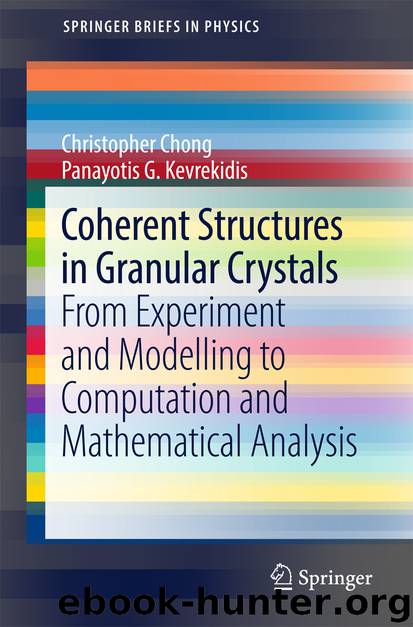Coherent Structures in Granular Crystals by Christopher Chong & Panayotis G. Kevrekidis

Author:Christopher Chong & Panayotis G. Kevrekidis
Language: eng
Format: epub
Publisher: Springer International Publishing, Cham
4.2 Connection with Experimental Results
A natural question that comes to mind regarding these elaborate structures (i.e., the dark breathers) is whether there is a realistic possibility to observe them in physical experiments. While such experiments can be devised (as discussed in the two previous chapters) for the more straightforward traveling wave and even shock-like excitations, the dark breathers bear a much more complex wave pattern involving both the alternation between adjacent sites and the profile. One thing that is important to remind the reader here is that, despite tremendous versatility in the experimental setup (different materials, different geometric shapes of the elements, different masses, etc. are all natural possibilities), it does not have the potential of distributed actuation. I.e., up to this point in time, granular crystals constitute systems that can be accurately (and in a non-autonomous fashion) driven from the boundaries. However, they cannot be initialized at will; the latter is an especially intriguing challenge for future work. Hence, a natural question arises about how to induce a dark breather in both theory and experiment in the absence of such an ability to initialize.
To bypass this constraint, we revert to the “dark” nature of the dark breather. Such a state can be thought of as arising from the destructive interference of two waves (near the center of the lattice). Hence, we can use this intuition to drive with opposite phase two plane waves at frequencies very near the upper band edge where we saw that dark breathers may exist. In this way, we enable the transmission of the plane waves (which only occurs within the linear band of the dispersion relation). Yet, as these waves propagate towards the center of the domain, the judicious selection of an anti-phase pattern (i.e., the -phase difference) produces an “interference fringe” at the center, which is preserved by the parity of the evolution dynamics. Around this vanishing center, a nonlinear pattern will emerge in the presence of the Hertzian nonlinearity (which will also respect the “staggered” i.e., proportional to , nature of the plane waves). However, which is the pattern that has a nodal point at the center, vibrates at frequency (near the band edge ), has a staggered spatial structure and is fundamentally nonlinear? It is, indeed, the dark breather. As a result, it would seem rather natural that this process produces a dark breather state in this driven (through the boundaries), yet intrinsically damped (in realistic experiments) system.
Fig. 4.3a Theoretical prediction for the velocity profile of a dark breather (its numerically exact profile is given by blue circles), as well as the evolution (green lines) of such a waveform over time in the experiment. The result of performing the same process as the experiment numerically produces the (red) dots. b Comparison of the detailed time evolution of the numerically exact (up to prescribed tolerance) dark breather (left) versus the numerical simulation (middle) and experimental process (right) output. Color intensity corresponds to velocity. c Comparison of the bifurcation diagram of the dark
Download
This site does not store any files on its server. We only index and link to content provided by other sites. Please contact the content providers to delete copyright contents if any and email us, we'll remove relevant links or contents immediately.
Whiskies Galore by Ian Buxton(41550)
Introduction to Aircraft Design (Cambridge Aerospace Series) by John P. Fielding(32900)
Small Unmanned Fixed-wing Aircraft Design by Andrew J. Keane Andras Sobester James P. Scanlan & András Sóbester & James P. Scanlan(32585)
Aircraft Design of WWII: A Sketchbook by Lockheed Aircraft Corporation(32141)
Craft Beer for the Homebrewer by Michael Agnew(17944)
Turbulence by E. J. Noyes(7725)
The Complete Stick Figure Physics Tutorials by Allen Sarah(7157)
The Institute by Stephen King(6812)
Kaplan MCAT General Chemistry Review by Kaplan(6621)
The Thirst by Nesbo Jo(6465)
Bad Blood by John Carreyrou(6289)
Modelling of Convective Heat and Mass Transfer in Rotating Flows by Igor V. Shevchuk(6237)
Learning SQL by Alan Beaulieu(6051)
Weapons of Math Destruction by Cathy O'Neil(5865)
Man-made Catastrophes and Risk Information Concealment by Dmitry Chernov & Didier Sornette(5682)
Permanent Record by Edward Snowden(5554)
Digital Minimalism by Cal Newport;(5410)
Life 3.0: Being Human in the Age of Artificial Intelligence by Tegmark Max(5207)
iGen by Jean M. Twenge(5181)
